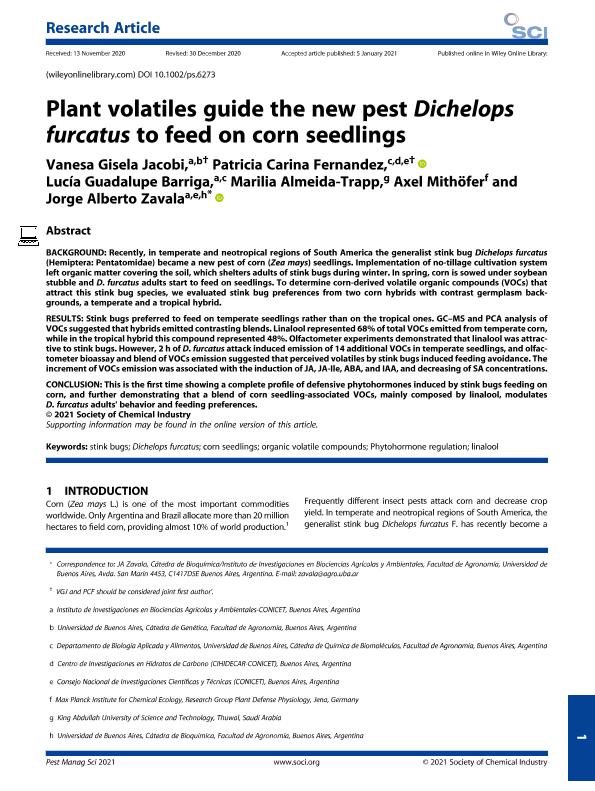Artículo
Plant volatiles guide the new pest Dichelops furcatus to feed on corn seedlings
Jacobi, Vanesa Gisela ; Fernandez, Patricia Carina
; Fernandez, Patricia Carina ; Barriga, Lucía Guadalupe; Almeida Alvin, Eliete; Abad, Sergio Fernando; Zavala, Jorge Alberto
; Barriga, Lucía Guadalupe; Almeida Alvin, Eliete; Abad, Sergio Fernando; Zavala, Jorge Alberto
 ; Fernandez, Patricia Carina
; Fernandez, Patricia Carina ; Barriga, Lucía Guadalupe; Almeida Alvin, Eliete; Abad, Sergio Fernando; Zavala, Jorge Alberto
; Barriga, Lucía Guadalupe; Almeida Alvin, Eliete; Abad, Sergio Fernando; Zavala, Jorge Alberto
Fecha de publicación:
01/2021
Editorial:
John Wiley & Sons Ltd
Revista:
Pest Management Science
ISSN:
1526-498X
Idioma:
Inglés
Tipo de recurso:
Artículo publicado
Clasificación temática:
Resumen
BACKGROUND: Recently, in temperate and neotropical regions of South America the generalist stink bug Dichelops furcatus (Hemiptera: Pentatomidae) became a new pest of corn (Zea mays) seedlings. Implementation of no-tillage cultivation system left organic matter covering the soil, which shelters adults of stink bugs during winter. In spring, corn is sowed under soybean stubble and D. furcatus adults start to feed on seedlings. To determine corn-derived volatile organic compounds (VOCs) that attract this stink bug species, we evaluated stink bug preferences from two corn hybrids with contrast germplasm backgrounds, a temperate and a tropical hybrid. RESULTS: Stink bugs preferred to feed on temperate seedlings rather than on the tropical ones. GC?MS and PCA analysis of VOCs suggested that hybrids emitted contrasting blends. Linalool represented 68% of total VOCs emitted from temperate corn, while in the tropical hybrid this compound represented 48%. Olfactometer experiments demonstrated that linalool was attractive to stink bugs. However, 2 h of D. furcatus attack induced emission of 14 additional VOCs in temperate seedlings, and olfactometer bioassay and blend of VOCs emission suggested that perceived volatiles by stink bugs induced feeding avoidance. The increment of VOCs emission was associated with the induction of JA, JA-Ile, ABA, and IAA, and decreasing of SA concentrations. CONCLUSION: This is the first time showing a complete profile of defensive phytohormones induced by stink bugs feeding on corn, and further demonstrating that a blend of corn seedling-associated VOCs, mainly composed by linalool, modulates D. furcatus adults´ behavior and feeding preferences.
Archivos asociados
Licencia
Identificadores
Colecciones
Articulos(CIHIDECAR)
Articulos de CENTRO DE INVESTIGACIONES EN HIDRATOS DE CARBONO
Articulos de CENTRO DE INVESTIGACIONES EN HIDRATOS DE CARBONO
Articulos(INBA)
Articulos de INST.DE INVEST. EN BIOCIENCIAS AGRICOLAS Y AMBIENTALES
Articulos de INST.DE INVEST. EN BIOCIENCIAS AGRICOLAS Y AMBIENTALES
Citación
Jacobi, Vanesa Gisela; Fernandez, Patricia Carina; Barriga, Lucía Guadalupe; Almeida Alvin, Eliete; Abad, Sergio Fernando; et al.; Plant volatiles guide the new pest Dichelops furcatus to feed on corn seedlings; John Wiley & Sons Ltd; Pest Management Science; 77; 5; 1-2021; 2444-2453
Compartir
Altmétricas



